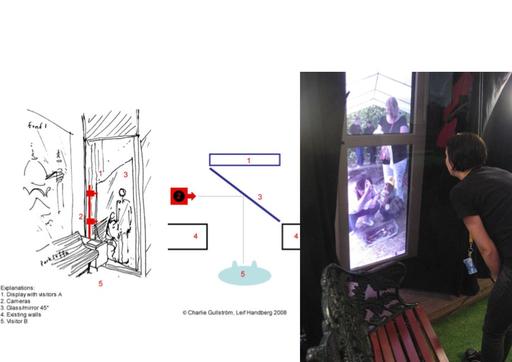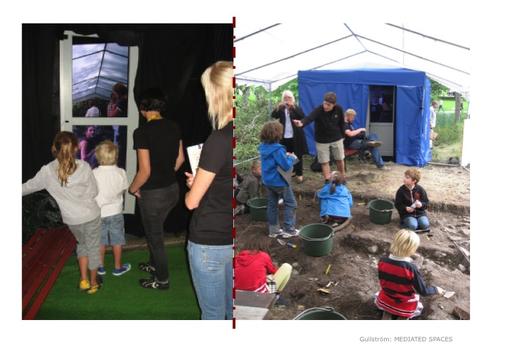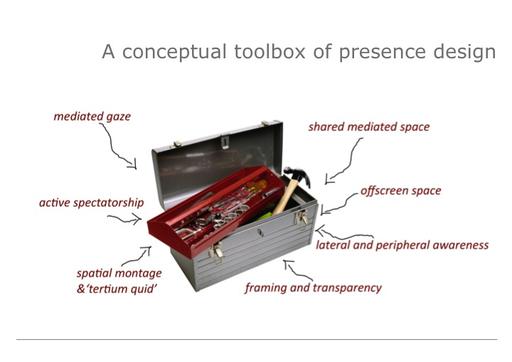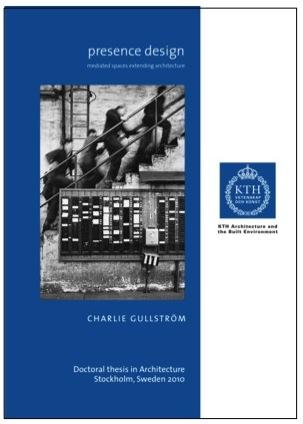PRESENCE DESIGN
Today’s skype and video conferencing applications are used by millions of people, but do not provide the embodied cognition that real life negotiations permit. Presence design thus concerns the combination of horizontal and vertical surfaces to create embedded virtual spaces that afford natural (verbal and non-verbal) interaction between users, while safeguarding ethical values and normative rules. For these hybrid spaces to become resilient normative social environments, trust, truth, responsibility, accountability and non-verbal communication are seen as essential design components.
See some short filmclips from previous work in presence design carried out by the KTH Smart Spaces research group here.


Above, the example of the Mediated Museum project 2008. KTH in collaboration with the Museum of National Antiquities, which was mediated to an architectural excavation site on Djurgården, the venue for the 1897 Art and INdustry exhibition.
Architects conventionally design physical spaces and material artefacts to support human interaction. Increasingly, however, we are drawn into the realms of digital, immaterial or hybrid design contexts. New building materials and design materials have become available, borrowed from the fields of media and communications. Our research and practice accordingly seeks to extend our conception of disciplinarity by examining the contribution of media, interaction and communication – specifically, the fusion of architecture and media technology that enables mediated presence and dialogic interaction across time and space: presence design and mediated spaces.
To date, there has been limited research to incorporate such immaterial spatial artefacts as result from synchronous video-mediated communication to architectural design, but its theoretical context is, in many ways, not new. As shown by Charlie Gullström's PhD Presence Design: Mediated Spaces Extending Architecture (2010), there was crucial involvement of architects in a cultural development that can be traced back to a few formative milieus of the 1960s and from which concepts such as ‘media space’ and ‘performative design’ originate. Generative design experiments of prototypical presence designers include Cedric Price, Gordon Pask within second-order cybernetics and numerous other researchers at MIT Media Lab, Stanford Institute and Xerox PARC. After a long gap, the engagement from architects is recently increasing, possibly facilitated by more accessible interaction design tools.[1] Today, many different terms are used to address architecture at the intersection of new media and interactive media.[2]
Gullström presents a Digital Toolbox that can be used to address aesthetic qualities in presence design. Mediated presence cannot be ensured by design, however, by acknowledging that certain features are related to spatial design, a presence designer can monitor them and, in effect, seek to reduce the ‘design friction’ that otherwise may inhibit e.g. trust and knowledge-sharing. She concludes that a presence-in-person paradigm prevails in our society, founded on the expectations of trust and knowledge-sharing between individuals. Her PhD addressed the contribution from presence design to architectural practice – as well as the reciprocal contribution from architecture to presence design – given that mediated spaces currently provide viable alternatives for meetings and interactions, hence with a fundamental impact on all human practices.

This research has shown that mediated spaces can provide sufficient audiovisual information about the remote space(s) and other person(s), allowing the subtleties of nonverbal communication to inform the interaction. Based on personal design experiences from collaborative research projects at KTH, Gullström found that in designing for presence, certain spatial features have an effect on the user’s ability to experience a mediated spatial extension (sense of a shared mediated space) which, in turn, can facilitate the experience of mediated presence. The conclusion is that certain spatial tools play an important role in the process in which trust and truth is negotiated, hence with an impact on knowledge-sharing.
References:

Gullström, C. 2010. Presence Design: Mediated Spaces Extending Architecture. Doctoral thesis. Stockholm: KTH (Download from KTH library database)
Shorter than a PhD, the following articles can be recommended:
Gullström, C. 2012. 'Design Frictions' in Springer AI & Society Journal of Knowledge, Culture and Communication, Special issue Witnessed Presence, (Gill, J.S., and Nevejan, C. eds.).
Gullström, C. 2010. ‘Mediated Windows: The Use of Framing and Transparency in Designing for Presence’, Footprint Journal, issue 6, ‘Digitally-Driven Architecture’ (Bier, H., and Knight, T. eds) ISSN / E-ISSN: 1875-1504 / 1875-1490 Publisher: Stichting Footprint & Technical University Delft, Delft School of Design
Slides from a lecture by Dr Charlie Gullström can be uploaded here: A DIgital Toolbox for Presence design, Lecture slides
[1] See Gullström (2010: 54ff; 107ff) for an overview of e.g. Gage (2007), Glanville (2007), Frazer (2005), Haque (2007), Cariani (2003), and works by Khan (2007), Roosegarde (2007)
[2] E.g. media space, hybrid space, cybrid space, mixed-reality architecture or hypersurfaces (Gullström ibid:37f)